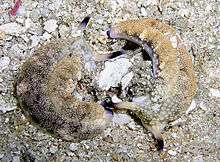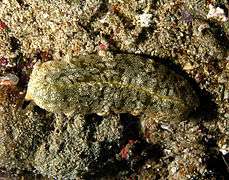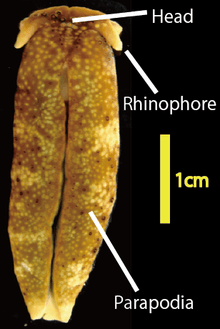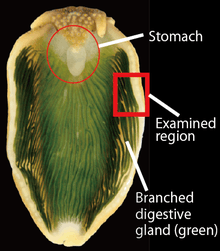Plakobranchus ocellatus
Plakobranchus ocellatus is a species of sea slug, a sacoglossan, a marine opisthobranch gastropod mollusk in the family Plakobranchidae.[1] It is found in shallow water in the Indo-Pacific region.
| Plakobranchus ocellatus | |
|---|---|
 | |
| Two Plakobranchus ocellatus seaslugs facing in opposite directions | |
| Scientific classification | |
| Kingdom: | |
| Phylum: | |
| Class: | |
| (unranked): | |
| Superfamily: | |
| Family: | |
| Genus: | |
| Species: | P. ocellatus |
| Binomial name | |
| Plakobranchus ocellatus (van Hasselt, 1824) | |
| Synonyms[1] | |
| |
Distribution
This species occurs in the Indo-Pacific.[1] Recent work on the photosynthetic abilities of Plakobranchus reveals that P. ocellatus is actually a species complex consisting of at least four distinct clades.[2]
Description

The body is broad, truncate, and rather flattened, up to 4 cm (1.6 in) long.[1] The head is flat and squarish, the rhinophores being folded longitudinally. The mouth is at the front apex of the head and the eyes are very close together, being visible through the semi-transparent skin of the head. The dorsal surface of the sea slug has a number of longitudinal ridges, but when at rest, the parapodia are folded up over the midline of the body so that the dorsal surface is concealed from view. On the underside, the foot is broad and long, but is not clearly demarcated from the mantle.[3] The ground colour of this sea slug is usually pale green, beige, or cream with large ocelli (spots similar to eyespots) of cream, brown, pink, and purple in varying shades. The sole of the foot also has ocelli.[1]
 Dorsal view of a freshly collected intact Plakobranchus ocellatus showing its head, rhinophores and parapodia. |
Habitat
These seaslugs live in sheltered, shallow water habitats with stones or gravel and silt.[1] They feed on a broad food spectrum, including members of the genera Halimeda, Caulerpa, Udotea, Acetabularia and further unidentified algae, with an emphasis on Halimeda macroloba.[2]
References
This article incorporates CC-BY-3.0 text from the reference.[1]
- Gofas, S. (2014). Plakobranchus ocellatus van Hasselt, 1824. Accessed through: World Register of Marine Species on 2014-11-08
- Christa G., Wescott L., Schäberle T.F., König G.M., Wägele H., (2013) What remains after 2 months of starvation? Analysis of sequestered algae in a photosynthetic slug, Plakobranchus ocellatus (Sacoglossa, Opisthobranchia), by barcoding. Planta. Feb;237(2):559-72. doi: 10.1007/s00425-012-1788-6. Epub 2012 Oct 30.
- Rao, K.V. (2015). "On two opisthobranchiate molluscs, Placobranchus ocellatus Hasselt and Discodoris boholiensis Bergh, from Indian waters not hitherto been recorded" (PDF). Journal of the Marine Biological Association of India. 3 (1&2): 253–255.
- Maeda T., Hirose E., Chikaraishi Y., Kawato M., Takishita K. et al. (2012). "Algivore or Phototroph? Plakobranchus ocellatus (Gastropoda) Continuously Acquires Kleptoplasts and Nutrition from Multiple Algal Species in Nature". PLoS ONE 7(7): e42024. doi:10.1371/journal.pone.0042024
- Jensen K.R. (2007) Biogeography of the Sacoglossa (Mollusca, Opisthobranchia). Bonner Zoologische Beiträge 55:255–281
External links
| Wikimedia Commons has media related to Plakobranchus ocellatus. |
- Hirose E. (2005). "Digestive System of the Sacoglossan Plakobranchus ocellatus (Gastropoda: Opisthobranchia): Light- and Electron-Microscopic Observations with Remarks on Chloroplast Retention". Zoolog Sci. 22(8): 905–916.
- Trench M. E, Trench R. K. & Muscatine L. (1970). "Utilization of photosynthetic products of symbiotic chloroplasts in mucus synthesis by Placobranchus ianthobapsus (Gould), Opisthobranchia, Sacoglossa". Comp Biochem Physiol. 37(1): 113–117.
- Photos of Plakobranchus ocellatus on Sealife Collection
